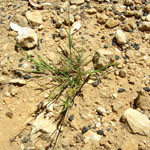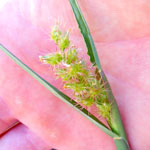Spiny burr grass
Common name:
- Spiny burr grass
Scientific name:
- Cenchrus longispinus (Hack.) Fernald
Other common names:
- Gentle Annie
- Innocent weed
Plant status
Catchment management authority boundaries
Regionally prohibited in the Glenelg Hopkins, Port Phillip and Western Port catchments.
Regionally controlled in the Mallee, Wimmera, North Central, Goulburn Broken, North East, West Gippsland and East Gippsland catchments.
Restricted in the Corangamite, West Gippsland and East Gippsland catchments.
Plant biology
Appearance
Herbaceous plant — Graminoid (grass, sedge or rush)
Description
Spiny burr grass is an erect or spreading annual summer growing grass.
Stems
Spiny burr grass produces several stems from the base which are branched, hairless and somewhat flattened, particularly at the base. They are either erect or spreading and ascending.
Roots are formed at basal nodes when in contact with soil.
Leaves
Leaves of spiny burr grass are wide and smooth but sometimes twisted and wrinkled. They have fine serrations and flattened sheaths growing to a length of 20cm and a width of 5 to 8mm. The ligule is a narrow membrane fringed with hairs 1 to 1.5mm long.
Flowers
Flowers of spiny burr grass have a spike-like panicle 3 to 8cm long consisting of up to 40 burrs and are often partially enclosed in a leaf sheath.
The burr is yellow to green, 3 to 7mm in diameter (excluding the spines) and comprising of 1 to 4 florets.
Spines are purple-tinged, spreading or reflexed, slender but broadened at the base. They are sharply pointed, finely barbed and rigid.
Fruit
No fruit.
Seeds
Spiny burr grass seeds are whitish with brown streaks or blotches, 3 to 4mm long, 2mm wide, ovoid, smooth and lacking a pappus.
Growth and lifecycle
Method of reproduction and dispersal
Spiny burr grass is spread by water, animals, fodder, clothing and machinery. The seed contains barbed spines on the burr which attach to wool, fur, clothing, bags and other fibrous materials.
Seedbank propagule persistence
Spiny burr grass can produce up to 1000 seeds per plant with some seeds remaining dormant for up to three years.
While some plants may survive a mild winter to produce a small crop of burrs, this species is essentially an annual. A mature plant produces seeds for only 1 year. The weed germinates in spring or summer with burr produced from December to April. Most plants die in autumn.
Preferred habitat
Spiny burr grass prefers temperate sub-humid and semi-arid regions where it grows well on low-fertility, sandy, well drained soils. It establishes readily on disturbed sites in the 250 to 500mm annual rainfall belt. The weed has some tolerance to frost and low temperatures.
Distribution
Spiny burr grass is well established in the dry farmlands of the Victorian and South Australian Mallee and in irrigated areas along the Murray River in both states.
Growth calendar
The icons on the following table represent the times of year for flowering, seeding, germination, the dormancy period of Spiny burr grass and also the optimum time for treatment.
| Jan | Feb | Mar | Apr | May | Jun | Jul | Aug | Sep | Oct | Nov | Dec | |
|---|---|---|---|---|---|---|---|---|---|---|---|---|
| Flowering | ||||||||||||
| Seeding | ||||||||||||
| Germination | ||||||||||||
| Dormancy | < | |||||||||||
| Treatment |
Impact
Impact on ecosystems and waterways
Spiny burr grass grows well on disturbed road edges and infests neglected areas and summer crops. The weed forms tussocks of up to 30cm high and 60cm across.
It grows in open, dry sandy conditions and is a pioneer plant of disturbed sandy soils. It also grows well under irrigation. Disturbance enhances invasiveness and can cause displacement of desirable grass species.
Agricultural and economic impacts
Spiny burr grass does not establish readily in pastures.
The burrs can become badly tangled in wool, lowering its value and making sheep difficult to handle. This can result in additional costs to handle burr-infested stock. Spines from the plant can easily puncture the skin of animals and affect the value of the hides. The weed is also a contaminant in dried fruit and may infest lucerne hay.
Social value and health impacts
The spines of spiny burr grass can easily puncture the skin of animals and has the potential to injure fauna. Spines may also injure humans.
Burrs are present for much of the year. The plant does not pose any restrictions to human movement except when burrs are present.
Management
Prescribed measures for the control of noxious weeds:
- application of a registered herbicide
- cultivation
- physical removal.
Read about prescribed measures for the control of noxious weeds.
Other management techniques
Changes in land use practices and spread prevention may also support spiny burr grass management after implementing the prescribed measures.